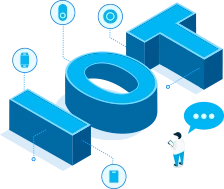Bluetooth Beacons are all the rage in the business world. They help business owners keep tabs on specific assets and human resources in the premises. You can also use beacon iOS to maintain environmental conditions in a room, maintain equipment on a factory floor, or help customers find items in a store.
The only challenging part is beacon deployment. You need to understand the kind of beacons to use, the configurations to implement, and the necessities for maintenance. All this comes with the cost of purchasing your own beacon and deploying it. Luckily, you can test how well your project will react to beacon technology using your iOS device, as long as you know how to approach the matter.
Read on to know more about utilizing iBeacon iOS:
How To Turn An iOS Device Into An iBeacon
As long as an iOS device supports data sharing through Bluetooth low energy, it can be turned into an iBeacon. However, the apps that use the device as an iBeacon need to be run in the foreground. For instance, point-of-sale apps can be used easily with such a device. In case you need to work with other iBeacon implementations, using dedicated hardware from third-party manufacturers will be necessary.
Ideally, there are three steps for turning your iOS device into an iBeacon, which are:
• Generating or obtaining a 128-bit UUID for the iOS device
• Creating a CLBeaconRegion object that contains the UUID value and corresponding minor and major values for the beacon.
• Use the Core Bluetooth framework for advertising the beacon
1. Obtain A UUID For Your Device
The most common way for identifying your iBeacon is through its UUID. When you are deploying multiple beacons, the UUID provides interested clients with information on the beacon’s purpose. The fewer the UUIDs you use, the better, since you need to use region monitoring to look for beacons that match your UUID.
You’ll need to use the uuidgen command-line tool to create new UUIDs for your beacons. Open the terminal and key in uudigen into the command line prior pressing return. The tool will produce a unique 128-bit value before formatting it as an ASCII, which is typically punctuated by hyphens.
2. Configure The Beacon Region
Once you create a UUID for the device, proceed to use the CLBeaconRegion object to configure the identity of your beacon. You can rely on the beacon region for advertising information later via Bluetooth. The specific values you need to configure include the UUID, the major, and the minor. The choices you make for these three values will dictate how apps interact with your ibeacon iOS device and interpret the information on it.
3. Advertise Your Beacon Over Bluetooth
Start broadcasting the identity of your beacon from your iOS device. You should use the Core Bluetooth framework for configuring the device as a Bluetooth peripheral. This step ensures your iOS device can use Bluetooth hardware to broadcast beacon information. Other devices will use this information for ranging and detecting the distance between them and the iOS device.
How iBeacons And Bluetooth BLE Work Together
iBeacons iOS consist of four components. Understanding how these components work together is a sure way to understanding your device. They can also help you master iBeacon configuration. The four components include:
• UUID: Known as Universally Unique Identifier in full, the UUID is a group of 32 hexadecimal digital that has been split into five groups. For instance, an UUID might look like: 3f779380-9d6f-11e5-b3e9-0002a5d5c51b. It helps you identify each device based on the application, owner, or manufacturer. It will also allow you to distinguish beacons in your network from those on other networks.
• Major: this represents a two-byte string that helps in identifying a smaller group of beacons within a larger one. For instance, an airline will use different majors to label beacons in the different airports, which helps identify the airport a traveler is in.
• Minor: this two-byte string helps in identifying individual beacons. For instance, the same airline will have different beacons placed close to the gate. The minor helps in telling them apart, making it easier to locate an item or person.
• TX Power: This configuration helps identify the range at which a beacon can broadcast information.
Proper iBeacon iOS Configuration
Every beacon will work in a similar manner – they broadcasting three IDs; the UUID, the Major ID, and the minor ID. You can have multiple beacons sharing a similar ID, especially when they are serving the same content within a large outdoor or indoor area. In the app, these beacons will look like a single large beacon that is broadcasting. Alternatively, you can give each beacon a different ID, despite broadcasting similar content.
Most beacons will also broadcast telemetry data, which can provide information concerning their battery charge. Some models will also send different data like temperature and air pressure. Apps can easily receive this data and make a corresponding response. However, most apps ignore the telemetry data, which will only be displayed by the manufacturer’s app. Remember; the app only serves as a database backend proxy, where the data is stored for examination later.
iBeacons are mostly configured through a manufacturer-provided app, with most manufacturers having easy-to-use applications for the process. Besides the IDs, the three other crucial values to consider during configuration include:
• Broadcasting power and range: this range is typically set between 1 and 10. A higher transmission power means a greater range but more battery consumption.
• Advertising interval: this is used to determine the frequency at which signals are sent. The minimum interval is 100 mms, with most beacons going up to 12 seconds. Short intervals translate to more battery power consumed. However, shorter intervals ensure that the app receives the beacon’s broadcasts in a timely fashion. You can determine the ideal interval based on your specific needs.
• Measured power/received signal strength indicator (RSSI): the strength of transmission is highly dependent on the transmitter and its transmission power. However, all this can be affected by disturbances like reflection. The RSSI comes in handy whenever you need to identify the location of a specific item while factoring in environmental factors.
The last essential configuration to make is to set a password for your iBeacon. Otherwise, you could lose control over the beacons were anyone with the configuration app to change your beacon’s IDs.
Common iBeacon iOS Issues
iBeacon technology is still growing. It is normal to go through a few challenges when deploying your beacons. Some of the most common issues with iBeacon in iOS and their challenges include:
1. Frequency Issues
Not all beacons function under the same frequency or transmit signals under the same power. The challenge app developers face is to make the beacon broadcast information to the user whenever they are within their proximity, even when the signals are weak. A lot of factors can affect beacon strength, including weather conditions, temperature, and device power. All these conditions can lead to delayed notification owing to low frequency levels. The solution is to design the app to make specific choices based on the information it is receiving.
2. Tracking During Triangulation
Three active beacons in close vicinity can result to this problem. The app finds it difficult to identify the range the user is in, which means that the messages won’t be sent accordingly. The best solution is to use a combination of Bluetooth signals and Wi-Fi triangulation to accurately determine location.
3. Navigating The App Store
One of the biggest issues is navigating the app store. Users need enough information to show that your beacon app will solve their problems. you can do this through:
• Explaining how the app functions within the app description
• You can include a short video to explain the app functionality
• Include a disclaimer on battery use and any other noteworthy aspects
Test The Beacons
Test the beacon and its app. You should ensure that the device broadcasts as desired and within a reasonable range. Watch out for any errors that could complicate the function of the device and the app. If necessary, do some fine-tuning to the configurations to make your beacon deployment successful.





























